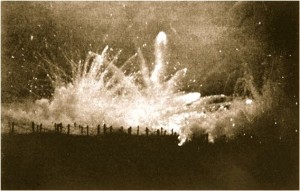What is the 1st Trumpet?
The first angel sounded his trumpet, and there came hail and fire mixed with blood, and it was hurled down on the earth. A third of the earth was burned up, a third of the trees were burned up, and all the green grass was burned up. (Revelation 8: 7)
The 1st trumpet appears to describe the world’s first global conflict: World War I (1914-1918).
World War I
World War I (aka “the Great War”) was expected to be “the war to end all wars.” It involved all of the world’s great economic powers: the Central Powers (Germany, Austria-Hungary, and the Ottoman Empire) versus the Allies (Great Britain, France, Russia, Italy, Japan, and the United States of America).
Hail & Fire Mixed with Blood
Explosions of bombs and firearms can be described as “hail and fire mixed with blood.”
Scorched Earth
In addition to the earth being scorched by the explosives, the military had a “scorched earth policy” to burn everything so that nothing was left for the enemy.
Unprecedented Carnage & Destruction
Thanks to the introduction of modern technology to warfare, this conflict resulted in unprecedented carnage and destruction. It included the first large-scale bombing from the air and large-scale civilian massacres (e.g. the Islamic Ottoman Empire’s genocide of Armenians, Assyrians, and Greeks). In addition, the war caused shortages in food and in medical supplies. During WWI, about 9 million soldiers and 6.5 million civilians died.[i] [ii]
The Collapse of the Ottoman Empire
The Koran teaches that in the end times, Islamic law (Sharia law) will rule the entire world. For more than 600 years, the Islamic Ottoman Empire had been systematically and violently conquering neighboring nations. The Ottoman Empire was attempting to establish an Islamic kingdom that would dominate the world.
The decline of the Ottoman Empire began with the Battle of Vienna on September 11, 1683. The battle was the first time that Poland and the Holy Roman Empire joined together to fight the Ottoman Empire. As a result of the Battle of Vienna, the Islamic Ottoman Empire “ceased to be a menace to the Christian world.”[iii]
The Islamic Ottoman Empire tried to regain its former glory through its involvement in World War I. Their side lost. In the aftermath of World War I, the Ottoman Empire collapsed and was officially dissolved. This led to the emergence of the new state of Turkey (which still uses the Ottoman flag) as well as the creation of modern Balkan and Middle Eastern states.[iv]
A National Home for the Jewish People
World War I took place before, during, and after the Jewish Shemitah year of Sept 1916 – Sept 1917. On November 2, 1917, the Balfour Declaration was issued:
“His Majesty’s government view with favour the establishment in Palestine of a national home for the Jewish people, and will use their best endeavours to facilitate the achievement of this object, it being clearly understood that nothing shall be done which may prejudice the civil and religious rights of existing non-Jewish communities in Palestine, or the rights and political status enjoyed by Jews in any other country.” (United Kingdom’s Foreign Secretary Arthur James Balfour)
Back in 70 AD, God allowed the 2nd Jewish Temple to be destroyed, the Jewish homeland taken from them, and the Jewish people scattered. In 1917, the Balfour Declaration declared a “national home” for the Jewish people.
In 1917, God restored part of the promised land to His chosen people. This restoration of the Jewish homeland took place immediately following a Sabbath year. Therefore, it could have been considered a Year of Jubilee (or the resumption of the Jubilee calendar).
References:
[i] Matthew White, Source List and Detailed Death Tolls for the Primary Megadeaths of the Twentieth Century
[ii] Clodfelter, Michael (2002). Warfare and Armed Conflicts- A Statistical Reference to Casualty and Other Figures, 1500–2000 2nd Ed.. ISBN 978-0-7864-1204-4. Page 479
[iii] 1683: The Siege of Vienna. History Today. http://www.historytoday.com/walter-leitsch/1683-siege-vienna
[iv] Mikhail, Alan (2011). Nature and Empire in Ottoman Egypt. Cambridge University Press. p. 7. ISBN 978-1-139-49955-2. Retrieved 11 June 2013.

Leave a Reply